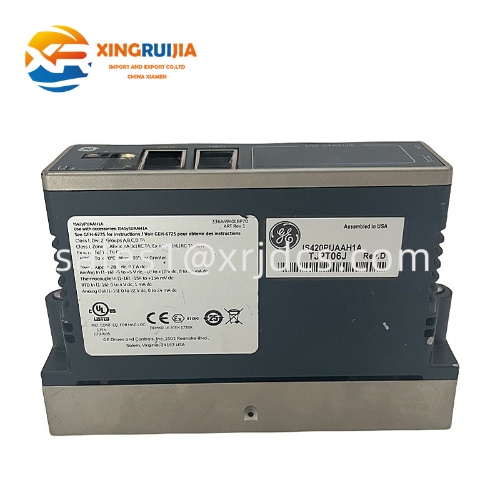GE IS420PUAAH1A – Universal I/O Module for Mark VIe Control Systems

Introduction
In high-reliability industrial applications such as gas or steam turbine control, flexibility and compact I/O architecture are highly valued. The GE IS420PUAAH1A is a universal input/output (I/O) pack designed for GE’s Mark VIe control system, offering wide analog and digital I/O functionality in a hot-swappable, high-density module. This I/O pack supports multiple signal types, enabling streamlined panel design and reduced system complexity.
In this detailed article, we’ll explore the technical specifications, architecture, typical use cases, installation/commissioning recommendations, advantages, and limitations of the IS420PUAAH1A.
Supported I/O Types
The IS420PUAAH1A is very flexible. Its 16 channels can each be independently configured for a variety of I/O modes:
-
Thermocouple (TC) input/output
-
RTD (resistance temperature detector) input/output
-
Voltage input (±5 V or ±10 V)
-
4–20 mA current input (with HART option)
-
0–20 mA current output (with HART)
-
Pulse accumulator input
-
Digital input
This broad I/O range enables the module to serve both analog process signals and discrete/pulse signals in a single I/O pack, helping to minimize system complexity and panel count.
Typical Applications
The IS420PUAAH1A is commonly used in:
-
Balance-of-Plant (BoP) Control Systems
In power plants, the module is used to monitor and control auxiliary systems (pumps, valves, sensors) that require analog I/O, digital I/O, and pulse counting. -
Distributed Control Systems (DCS)
Because of its flexibility (thermocouple, RTD, mA, voltage), it can be part of a distributed I/O architecture to aggregate different kinds of process measurements in one module. -
Turbine Control Systems
In GE Mark VIe turbine controls, it can serve as a part of the I/O rack to handle process measurements, temperature sensors, setpoints, and control signals. -
Field Instrumentation Consolidation
For plants with mixed instrumentation (analog sensors + discrete devices + pulse counters), this universal I/O pack reduces the number of separate modules / channel types needed. -
Maintenance-Friendly Designs
Thanks to hot-swap and auto-reconfigure, it’s suited for systems needing high uptime and ease of replacement.
Installation & Commissioning Recommendations
To deploy the IS420PUAAH1A properly, here are some engineering best practices:
-
Software Version Check
-
Ensure the control system is running ControlST V07.02.00C or later.
-
Verify module firmware version is compatible with your system.
-
-
Wiring & Panel Layout
-
Use the “black sections” logically: group I/O types so that channels of similar signal type are physically grouped — this helps wiring and commissioning.
-
Ensure correct shielding, grounding, and direction of thermocouple / RTD wires according to GE recommendations.
-
-
Environmental Control
-
The module supports –40 °F (~–40°C) to +158 °F (~+70 °C).
-
Maintain controlled humidity (5–95% non-condensing) to prevent condensation and corrosion.
-
-
Commissioning & Testing
-
After installation, use test signals for each I/O type (thermocouple, RTD, 4–20 mA, etc.) and validate readings in the control system.
-
Test hot-swap: power down one module (if allowed), insert replacement, and verify auto-reconfiguration works correctly.
-
Validate scan rates: confirm that 10 ms frame rate is properly configured and realized.
-
-
Maintenance Strategy
-
Keep spare PUAA modules on hand for fast replacement.
-
Periodically monitor I/O performance (offset drift, noise, accuracy) during preventive maintenance.
-
Back up the I/O configuration (channel mapping, scaling) so when modules are replaced, configuration can be quickly restored or validated.
-
Advantages for Engineers & System Designers
-
High Flexibility: Ability to handle thermocouples, RTDs, current I/O, voltage I/O, digital, pulse — all in one 16-channel pack.
-
Reduced Footprint: Independent “black section” wiring means fewer separate modules and panels are needed, saving space.
-
Reliable Performance: With 10 ms frame rate and 0.1% accuracy, it's suitable for many process control tasks.
-
Hot-Swap for High Availability: Modules can be replaced during runtime without shutting down the control system.
-
Auto-Reconfiguration: Simplifies maintenance and reduces configuration errors.
-
Robust Operating Range: Wide temperature range ensures usability in harsh environments.
Limitations & Things to Be Aware Of
-
Simplex Only: According to its spec, this I/O pack supports simplex, not redundant I/O.
-
Fixed Frame Rate: 10 ms is good, but not suitable for very high-speed control loops requiring sub-ms sampling.
-
Power Consumption: Depending on the I/O configuration, power per channel (especially mA output) can be substantial — design your power budget accordingly.
-
Channel Isolation: While channel-to-channel isolation is provided in some specs (~250 V), this may not be sufficient for very high-voltage or noise-sensitive designs.
-
Thermocouple Considerations: Correct wiring and cold-junction compensation are required to achieve accurate TC readings.
-
ControlST Version Requirement: Older control systems not running the required ControlST version may not fully support the module’s advanced features.


